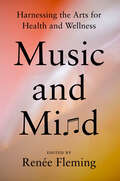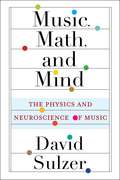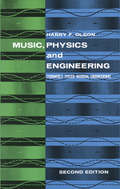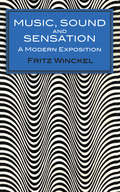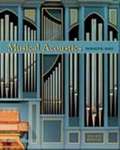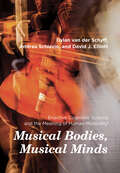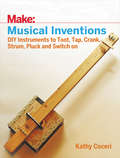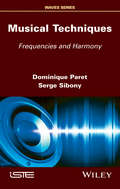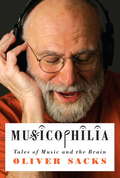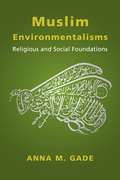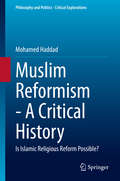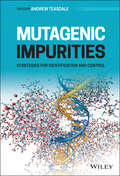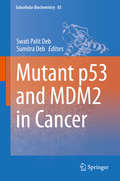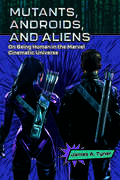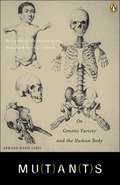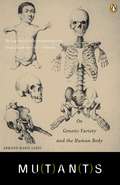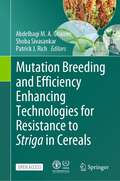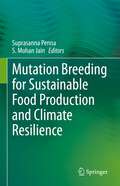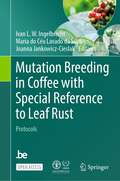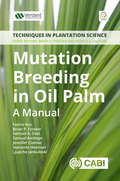- Table View
- List View
Music and Mind: Harnessing the Arts for Health and Wellness
by Edited by Renée Fleming"This book inspires us all to immerse ourselves in the vast potential of music and other creative arts to heal our wounds, sharpen our minds, enliven our bodies, and restore our broken connections.&” —Bessel van der Kolk, #1 New York Times bestselling author of The Body Keeps the ScoreWorld-renowned soprano and arts/health advocate Renée Fleming curates a collection of essays from leading scientists, artists, creative arts therapists, educators, and healthcare providers about the powerful impacts of music and the arts on health and the human experienceChapters include: Ann Patchett, &“How to Fall in Love with Opera&” Yo-Yo Ma, &“Nature, Culture, and Healing&”Aniruddh D. Patel, &“Musicality, Evolution, and Animal Responses to Music&”Richard Powers, &“The Parting Glass"Daniel J. Levitin, &“What Does It Mean to be Musical?&” Anna Deavere Smith, &“Healing Arts&” Rosanne Cash, &“Rabbit Hole&” Rhiannon Giddens, &“How Music Shows Us What It Means to Be Human&”Robert Zatorre, &“Musical Enjoyment and the Reward Circuits of the Brain&”Concetta Tomaino, &“Music and Memory&”A compelling and growing body of research has shown music and arts therapies to be effective tools for addressing a widening array of conditions, from providing pain relief andalleviating anxiety and depression to regaining speech after stroke or traumatic brain injury, and improving mobility for people with disorders that include Parkinson&’s disease and MS.In Music and Mind Renée Fleming draws upon her own experience as an advocate to showcase the breadth of this booming field, inviting leading experts to share their discoveries. In addition to describing therapeutic benefits, the book explores evolution, brain function, childhood development, and technology as applied to arts and health.Much of this area of study is relatively new, made possible by recent advances in brain imaging, and supported by theNational Institutes of Health, major hospitals, and universities. This work is sparking an explosion of public interest in the arts and health sector.Fleming has presented on this material in over fifty cities across North America, Europe, and Asia, collaborating with leading researchers, policy-makers, and practitioners. With essays from notable musicians, writers, and artists, as well as leading neuroscientists, Music and Mind is a groundbreaking book, the perfect introduction and overview of this exciting new field.
Music as Biology
by Dale PurvesWhy do human beings find some tone combinations consonant and others dissonant? Why do we make music using only a small number of scales out the billions that are possible? Dale Purves shows that rethinking music theory in biological terms offers a new approach to centuries-long debates about the organization and impact of music.
Music, Forced Migration and Emplacement: Sounds of Asylum Bristol (Leisure Studies in a Global Era)
by Nicola De Martini UgolottiThis book analyses the negotiation of place, belonging and uncertainty enacted by a group of 60 men and women seeking asylum who gathered weekly in a community space in Bristol, UK, to share songs, memories, laughter, and precariousness with other established and new city-dwellers. Building on a rich corpus of ethnographic data, this book explores music-making to address “what goes unnoticed” in existing ways of thinking about forced migration. By looking at the junctures where leisure, forced migration and urban analyses intersect with grassroot solidarity with and by people seeking asylum, it offers an interdisciplinary reading of music, forced migration and emplacement for scholars across leisure, anthropology, sociology, and geography. This book contributes and provokes novel discussions regarding refugees’ everyday experiences and negotiations of precariousness, suspension, and marginality in Britain.
Music, Math, and Mind: The Physics and Neuroscience of Music
by Professor David SulzerWhy does a clarinet play at lower pitches than a flute? What does it mean for sounds to be in or out of tune? How are emotions carried by music? Do other animals perceive sound like we do? How might a musician use math to come up with new ideas?This book offers a lively exploration of the mathematics, physics, and neuroscience that underlie music in a way that readers without scientific background can follow. David Sulzer, also known in the musical world as Dave Soldier, explains why the perception of music encompasses the physics of sound, the functions of the ear and deep-brain auditory pathways, and the physiology of emotion. He delves into topics such as the math by which musical scales, rhythms, tuning, and harmonies are derived, from the days of Pythagoras to technological manipulation of sound waves. Sulzer ranges from styles from around the world to canonical composers to hip-hop, the history of experimental music, and animal sound by songbirds, cetaceans, bats, and insects. He makes accessible a vast range of material, helping readers discover the universal principles behind the music they find meaningful.Written for musicians and music lovers with any level of science and math proficiency, including none, Music, Math, and Mind demystifies how music works while testifying to its beauty and wonder.
Music, Physics and Engineering (Dover Books On Music Ser.)
by Harry F. OlsonNow thoroughly revised and enlarged, this book offers the most comprehensive coverage available of all aspects of the production, reception, and reproduction of sound. Written clearly and concisely, all its chapters can be understood without specialized training in music, physics, engineering, or mathematics.Dr. Olson discusses the nature of sound waves; explains the division of sound into scale patterns and the traditional method of notating them; describes the individual characteristics of all musical instruments currently in use (including the human voice); shows how the ears hear; discusses concert hall and recording studio acoustics, amplification systems, etc; describes the elements of sound reproduction systems from the telephone to the stereo record player; and concludes with a new chapter on the production, development, and potentialities of electronic music.Under these broad headings, readers will find a close analysis of the way in which a violin produces sound; descriptions of carbon, crystal, dynamic, velocity, and unidirectional microphones; a comparison of the relative absorbency of 22 acoustic materials, building materials, and objects; a description of how music can be produced by a digital computer; and much, much more. Conductors will find suggestions on positioning their orchestras; performers will understand the dynamics of their instruments; recording engineers and acousticians will discover a remarkably comprehensive reference work; and music teachers, students, physicists, and enthusiasts in general will find easy access to a vast wealth of information.
Music, Sound and Sensation: A Modern Exposition
by Fritz WinckelRelated closely to the field of physical acoustics is that of psychoacoustics, which deals with the phenomena of musical hearing from a psychological and aesthetic point of view. One of the major contributors to our understanding of the subject is Fritz Winckel. When this book first appeared in German in 1960, reviewers pressed for an English translation. This Dover volume is an answer to that demand: it makes Professor "Winckel's important study generally available to English-language readers for the very first time." It has been extensively revised and updated by the author.In his thought-provoking study, Professor Winckel applies the findings of technical researches in acoustics to the practice of music, covering many different aspects of recent psychoacoustical researches: the evaluation of loudness and the dissolution power of the car; the influence of the acoustical properties of the concert hall on the hearing process; the function of time variation and rhythm in musical perception; the evaluation of the sound spectrum including the unharmonic components. He surveys extensively the German and English literature in the field, organizing his information into chapters on stationary sound, the onset behavior of sound, the concept of space, the concept of time, the evaluation of sound through the hearing mechanism, unclarity in musical structures, simultaneously sounding tones, electroacoustic sound structure, and the effect of music on the listener.This book should prove equally useful to acousticians, sound engineers, and others working in this area of applied physics and to composers, performers, and musicologists concerned with the technical aspects of music. Psychologists working in the field of sense perception will also find much of value here.New translation by Thomas Binkley of the 1960 German edition of Phänomene des musikalischen Hörens, with revisions and corrections by the author.
Music, Sound and Space
by Georgina BornMusic, Sound and Space is the first collection to integrate research from musicology and sound studies on music and sound as they mediate everyday life. Music and sound exert an inescapable influence on the contemporary world, from the ubiquity of MP3 players to the controversial use of sound as an instrument of torture. In this book, leading scholars explore the spatialisation of music and sound, their capacity to engender modes of publicness and privacy, their constitution of subjectivity, and the politics of sound and space. Chapters discuss music and sound in relation to distinctive genres, technologies and settings, including sound installation art, popular music recordings, offices and hospitals, and music therapy. With international examples, from the Islamic soundscape of the Kenyan coast, to religious music in Europe, to First Nation musical sociability in Canada, this book offers a new global perspective on how music and sound and their spatialising capacities transform the nature of public and private experience.
Musical Acoustics (Third Edition)
by Donald HallAn introductory course on the production, propagation, and perception of sound as it relates to music and musical instruments
Musical Bodies, Musical Minds: Enactive Cognitive Science and the Meaning of Human Musicality
by David J. Elliott Dylan van der Schyff Andrea SchiavioAn enactive account of musicality that proposes new ways of thinking about musical experience, musical development in infancy, music and evolution, and more.Musical Bodies, Musical Minds offers an innovative account of human musicality that draws on recent developments in embodied cognitive science. The authors explore musical cognition as a form of sense-making that unfolds across the embodied, environmentally embedded, and sociomaterially extended dimensions that compose the enactment of human worlds of meaning. This perspective enables new ways of understanding musical experience, the development of musicality in infancy and childhood, music&’s emergence in human evolution, and the nature of musical emotions, empathy, and creativity. Developing their account, the authors link a diverse array of ideas from fields including neuroscience, theoretical biology, psychology, developmental studies, social cognition, and education. Drawing on these insights, they show how dynamic processes of adaptive body-brain-environment interactivity drive musical cognition across a range of contexts, extending it beyond the personal (inner) domain of musical agents and out into the material and social worlds they inhabit and influence. An enactive approach to musicality, they argue, can reveal important aspects of human being and knowing that are often lost or obscured in the modern technologically driven world.
Musical Inventions: DIY Instruments to Toot, Tap, Crank, Strum, Pluck, and Switch On
by Kathy CeceriPeople have been playing music on homemade instruments for thousands of years. But creating new instruments is much more than an art form. When you want to make a note sound higher or lower, you have to change the sound waves coming out of the instrument. That's science! When you explore the way different materials produce different sounds, that's engineering. When you speed up or slow down a song, you're counting beats -- using math. And technology makes electronic instruments and devices to record and play back music possible.
Musical Techniques: Frequencies and Harmony
by Dominique Paret Serge SibonyThis book is built to start from elementary and fundamental bases to the first degrees of harmony. It provides many theoretical and technical bases of music, presenting in detail relations between physics and music (harmonics, frequency and time spectrum, dissonance, etc.), physiological relations with human body and education.
Musicophilia: Tales Of Music And The Brain (Picador Classic Ser.)
by Oliver SacksRevised and ExpandedWith the same trademark compassion and erudition he brought to The Man Who Mistook His Wife for a Hat, Oliver Sacks explores the place music occupies in the brain and how it affects the human condition. In Musicophilia, he shows us a variety of what he calls "musical misalignments." Among them: a man struck by lightning who suddenly desires to become a pianist at the age of forty-two; an entire group of children with Williams syndrome, who are hypermusical from birth; people with "amusia," to whom a symphony sounds like the clattering of pots and pans; and a man whose memory spans only seven seconds-for everything but music. Illuminating, inspiring, and utterly unforgettable, Musicophilia is Oliver Sacks' latest masterpiece.From the Trade Paperback edition.
Musimathics: The Mathematical Foundations of Music, Volume 1
by Gareth LoyMathematics can be as effortless as humming a tune, if you know the tune, writes Gareth Loy. In Musimathics, Loy teaches us the tune, providing a friendly and spirited tour of the mathematics of music--a commonsense, self-contained introduction for the nonspecialist reader. It is designed for musicians who find their art increasingly mediated by technology, and for anyone who is interested in the intersection of art and science. In this volume, Loy presents the materials of music (notes, intervals, and scales); the physical properties of music (frequency, amplitude, duration, and timbre); the perception of music and sound (how we hear); and music composition. Musimathics is carefully structured so that new topics depend strictly on topics already presented, carrying the reader progressively from basic subjects to more advanced ones. Cross-references point to related topics and an extensive glossary defines commonly used terms. The book explains the mathematics and physics of music for the reader whose mathematics may not have gone beyond the early undergraduate level. Calling himself "a composer seduced into mathematics," Loy provides answers to foundational questions about the mathematics of music accessibly yet rigorously. The topics are all subjects that contemporary composers, musicians, and musical engineers have found to be important. The examples given are all practical problems in music and audio. The level of scholarship and the pedagogical approach also make Musimathics ideal for classroom use. Additional material can be found at a companion web site.
Muslim Environmentalisms: Religious and Social Foundations
by Anna M. GadeHow might understandings of environmentalism and the environmental humanities shift by incorporating Islamic perspectives? In this book, Anna M. Gade explores the religious and cultural foundations of Islamic environmentalisms. She blends textual and ethnographic study to offer a comprehensive and interdisciplinary account of the legal, ethical, social, and empirical principles underlying Muslim commitments to the earth.Muslim Environmentalisms shows how diverse Muslim communities and schools of thought have addressed ecological questions for the sake of this world and the world to come. Gade draws on a rich spectrum of materials―scripture, jurisprudence, science, art, and social and political engagement―as well as fieldwork in Indonesia and Southeast Asia. The book brings together case studies in disaster management, educational programs, international development, conservation projects, religious ritual and performance, and Islamic law to rethink key theories. Gade shows that the Islamic tradition leads us to see the environment as an ethical idea, moving beyond the established frameworks of both nature and crisis. Muslim Environmentalisms models novel approaches to the study of religion and environment from a humanistic perspective, reinterpreting issues at the intersection of numerous academic disciplines to propose a postcolonial and global understanding of environment in terms of consequential relations.
Muslim Reformism - A Critical History: Is Islamic Religious Reform Possible? (Philosophy and Politics - Critical Explorations #11)
by Mohamed HaddadThis book examines the evolution of Islam in our modern world. The renowned Tunisian scholar Mohamed Haddad traces the history of the reformist movement and explains recent events related to the Islamic religion in Muslim countries and among Muslim minorities across the world. In scholarly terms, he evaluates the benefits and drawbacks of theological-political renovation, neo-reformism, legal reformism, mystical reformism, radical criticism, comprehensive history and new approaches within the study of Islam. The book brings to life the various historical, sociological, political and theological challenges and debates that have divided Muslims since the 19th century. The first two chapters address failed reforms in the past and introduce the reader to classical reformism and to Mohammed Abduh. Haddad ultimately proposes a non-confessional definition of religious reform, reinterpreting and adjusting a religious tradition to modern requirements. The second part of the book explores perspectives on contemporary Islam, the legacy of classical reformism and new paths forward. It suggests that the fundamentalism embodied in Wahhabism and Muslim Brotherhood has failed. Traditional Islam no longer attracts either youth or the elites. Mohamed Haddad shows how this paves the way for a new reformist departure that synthesizes modernism and core Islamic values.
Mutagenic Impurities: Strategies for Identification and Control
by Andrew TeasdaleLearn to implement effective control measures for mutagenic impurities in pharmaceutical development In Mutagenic Impurities: Strategies for Identification and Control, distinguished chemist Andrew Teasdale delivers a thorough examination of mutagenic impurities and their impact on the pharmaceutical industry. The book incorporates the adoption of the ICH M7 guideline and focuses on mutagenic impurities from both a toxicological and analytical perspective. The editor has created a primary reference for any professional or student studying or working with mutagenic impurities and offers readers a definitive narrative of applicable guidelines and practical, tested solutions. It demonstrates the development of effective control measures, including chapters on the purge tool for risk assessment. The book incorporates a discussion of N-Nitrosamines which was arguably the largest mutagenic impurity issue ever faced by the pharmaceutical industry, resulting in the recall of Zantac and similar drugs resulting from N-Nitrosamine contamination. Readers will also benefit from the inclusion of: A thorough introduction to the development of regulatory guidelines for mutagenic and genotoxic impurities, including a historical perspective on the development of the EMEA guidelines and the ICH M7 guideline An exploration of in silico assessment of mutagenicity, including use of structure activity relationship evaluation as a tool in the evaluation of the genotoxic potential of impurities A discussion of a toxicological perspective on mutagenic impurities, including the assessment of mutagenicity and examining the mutagenic and carcinogenic potential of common synthetic reagents Perfect for chemists, analysts, and regulatory professionals, Mutagenic Impurities: Strategies for Identification and Control will also earn a place in the libraries of toxicologists and clinical safety scientists seeking a one-stop reference on the subject of mutagenic impurity identification and control.
Mutant p53 and MDM2 in Cancer
by Swati Palit Deb Sumitra DebThis book provides the readers with an overview of research on p53, which has been shown to play a role in numerous crucial biological pathways in normal and cancer cells. Leading scientist in the field, who have all made direct contributions to the understanding of the molecular events underpinning p53 function, have been invited to contribute the various chapters, which discuss the current knowledge of the signaling cascades that are activated by mutations in p53 and overexpression of MDM2, frequently found in human cancer and are major causes of oncogenesis. This book features chapters on the molecular basis of oncogenesis induced by gain of function mutation of p53, signaling pathways induced by MDM2 overexpression, control of mutant or wild-type p53 function by MDM2 and MDMX, p53 mutation in hereditary cancer and structural aspects that activate mutant p53 which can be targeted by drug therapy. This book should be useful for scientists at all levels.
Mutants, Androids, and Aliens: On Being Human in the Marvel Cinematic Universe
by James A. TynerIn both literature and film, mutants, androids, and aliens have long functioned as humanity’s Other—nonhuman bodies serving as surrogates to explore humanity’s prejudice, bigotry, and hatred. Scholars working in fields of feminism, ethnic studies, queer studies, and disability studies, among others, have deconstructed representations of the Othered body and the ways these fictional depictions provide insight into the contested terrains of identity, subjectivity, and personhood. In science fiction more broadly and the superhero genre in particular, the fictional Other—often a superhero or a villain—is juxtaposed against the normal human, and such Others have long been the subject of academic investigation. Author James A. Tyner shifts this scholarly focus to consider the ordinary humans who ally with or oppose Othered superheroes. Law enforcement officers, military officials, politicians, and the countless, nameless civilians are all examples of humans who try to make sense of a rapidly changing more-than-human and other-than-human universe. The resulting volume, Mutants, Androids, and Aliens: On Being Human in the Marvel Cinematic Universe, provides a critical posthumanist reading of being human in the Marvel Cinematic Universe (MCU). Centering the MCU’s secondary human characters, including Matthew Ellis, Ellen Nadeer, Rosalind Price, as well as Jimmy Woo, Sadie Deever, Holden Radcliffe, and others, Tyner considers how these characters attempt to monitor, incarcerate, or exterminate those beings considered "unnatural" and thus threatening. Placing into conversation posthumanism, environmental ethics, and myriad philosophical and biological ontologies of life and death, Tyner maintains that the superhero genre reflects the current complexities of meaningful life—and of what happens in society when "the human" is no longer the unquestioned normative standard.
Mutants: On Genetic Variety and the Human Body
by Armand Marie LeroiStepping effortlessly from myth to cutting-edge science, Mutants gives a brilliant narrative account of our genetic code and the captivating people whose bodies have revealed it--a French convent girl who found herself changing sex at puberty; children who, echoing Homer's Cyclops, are born with a single eye in the middle of their foreheads; a village of long-lived Croatian dwarves; one family, whose bodies were entirely covered with hair, was kept at the Burmese royal court for four generations and gave Darwin one of his keenest insights into heredity. This elegant, humane, and engaging book "captures what we know of the development of what makes us human" (Nature).
Mutants: On Genetic Variety and the Human Body
by Armand Marie LeroiVisit Armand Marie Leroi on the web: http://armandleroi.com/index.htmlStepping effortlessly from myth to cutting-edge science, Mutants gives a brilliant narrative account of our genetic code and the captivating people whose bodies have revealed it--a French convent girl who found herself changing sex at puberty; children who, echoing Homer's Cyclops, are born with a single eye in the middle of their foreheads; a village of long-lived Croatian dwarves; one family, whose bodies were entirely covered with hair, was kept at the Burmese royal court for four generations and gave Darwin one of his keenest insights into heredity. This elegant, humane, and engaging book "captures what we know of the development of what makes us human" (Nature).
Mutation Breeding and Efficiency Enhancing Technologies for Resistance to Striga in Cereals
by Abdelbagi M. A. Ghanim Shoba Sivasankar Patrick J. RichThis open access book is a compilation of protocols developed through a Coordinated Research Project of the Joint FAO/IAEA Center of Nuclear Techniques in Food and Agriculture, specifically focused on mutation breeding for resistance to Striga. The book consists of three sections; (i) a general introduction on Striga biology and impact and mutagenesis in cereal crops; (ii) protocol chapters focusing on field, screenhouse and laboratory screening and diagnostic for resistance to Striga asiatica and S. hermonthica in sorghum, upland rice and maize, and; (iii) efficiency enhancing technologies such as rapid crop cycling, doubled haploid production and genomics for mutation discovery and marker development. These chapters were written by well recognized experts in Striga biology and physiology, and cereal breeders. The book is intended to serve as a unique reference and guide for plant breeders and geneticists engaged in breeding for resistance to Striga in cereals.
Mutation Breeding for Sustainable Food Production and Climate Resilience
by S. Mohan Jain Suprasanna PennaThis book highlights the recent progress on the applications of mutation breeding technology in crop plants. Plant breeders and agriculturists are faced with the new challenges of climate change, human population growth, and dwindling arable land and water resources which threaten to sustain food production worldwide. Genetic variation is the basis which plant breeders require to produce new and improved cultivars. The understanding of mutation induction and exploring its applications has paved the way for enhancing genetic variability for various plant and agronomic characters, and led to advances in gene discovery for various traits. Induced mutagenesis has played a significant role in crop improvement and currently, the technology has resulted in the development and release of more than 3600 mutant varieties in most of the crop plants with great economic impact. The field of ‘mutation breeding’ has come long way to become an important approach for crop improvement. This book covers various methodologies of mutation induction, screening of mutants, genome editing and genomics advances and mutant gene discovery. The book further discusses success stories in different countries and applications of mutation breeding in food crops, horticultural plants and plantation crops.This informative book is very useful to plant breeders, students and researchers in the field of agriculture, plant sciences, food science and genetics.
Mutation Breeding in Coffee with Special Reference to Leaf Rust: Protocols
by Joanna Jankowicz-Cieslak Ivan L. W. Ingelbrecht Maria do Céu Lavado da SilvaThis open-access book provides a comprehensive overview of current methodologies for improving resistance to leaf rust in coffee, one of the world's most important cash crops and beverages. Coffea arabica L. (Arabica) accounts for about 60% of the world's coffee production. Coffee leaf rust (CLR), caused by the fungus Hemileia vastatrix is the major disease affecting Arabica coffee resulting in losses of over $1 billion annually. The geographical distribution of CLR is expanding due to climate change. Moreover, the genetic improvement of Arabica coffee is constrained due to its very narrow genetic base. This protocol book introduces essential concepts of mutation breeding as an efficient tool to increase the genetic diversity of Arabica coffee and presents practical methods on mutation induction and screening for resistance to CLR. Current breeding approaches, challenges and opportunities for Arabica coffee improvement are briefly reviewed and a survey of common coffee diseases with emphasis on CLR is presented. Practical protocols for mutation induction and screening for resistance to CLR are described, including novel methods for single-cell mutagenesis using in vitro cell and tissue culture techniques and for genome-wide screening of induced mutations using genomics tools. Each protocol chapter has an introduction and is supported by example results. Given the impact of recent CLR epidemics on Arabica coffee production in Latin America, the book is intended to serve as a timely reference and guide for students and researchers in the agricultural sciences, plant pathologists and breeders, as well as growers and end-users interested in producing novel coffee genotypes for genetic studies, breeding, and commercial applications.
Mutation Breeding in Oil Palm: A Manual (Techniques in Plantation Science #5)
by Brian Forster Fazrin Nur Peter D. Caligari Samual A. Osei Samuel Amiteye Jennifer Ciomas Soeranto Hoeman Ljupcho JankuloskiThis is a practical guide to mutation breeding in oil palm, representing completely novel work supported by the Plant Breeding and Genetics Section of the Joint FAO/IAEA Division (Vienna, Austria). Oil palm is the top oil crop and the only major crop and only oil crop not to have been improved by plant mutation breeding. The manual is hands-on, providing step-by-step illustrated methods in mutation induction, mutation detection and mutant line development for oil palm improvement. Presenting sound practices based on scientific innovation and knowledge, this guide provides techniques integrated with expertise and is authored by practitioners actively engaged in oil palm seed production and breeding. Promoting green, eco-friendly agriculture, this book features coverage of: Radio-sensitivity testing Challenges and opportunities for mutation breeding Protocol for developing mutant generations for mutant screening Services in irradiation treatments The only available resource containing protocols and guidelines on how oil palm can be manipulated for mutation breeding, this book is essential reading for oil palm breeders, seed producers and plantation companies, oil palm traders, students and research institutes across the world. It provides a resource for training, a knowledge base for people new to oil palm and a reference guide for managers, to ensure best practices in maximising sustainability and production of this important crop. .
Mutation Breeding in Oil Palm: A Manual (Techniques in Plantation Science #5)
by Brian Forster Fazrin Nur Samual A. Osei Samuel Amiteye Jennifer Ciomas Soeranto Hoeman Ljupcho JankuloskiThis is a practical guide to mutation breeding in oil palm, representing completely novel work supported by the Plant Breeding and Genetics Section of the Joint FAO/IAEA Division (Vienna, Austria). Oil palm is the top oil crop and the only major crop and only oil crop not to have been improved by plant mutation breeding. The manual is hands-on, providing step-by-step illustrated methods in mutation induction, mutation detection and mutant line development for oil palm improvement. Presenting sound practices based on scientific innovation and knowledge, this guide provides techniques integrated with expertise and is authored by practitioners actively engaged in oil palm seed production and breeding. Promoting green, eco-friendly agriculture, this book features coverage of: Radio-sensitivity testing Challenges and opportunities for mutation breeding Protocol for developing mutant generations for mutant screening Services in irradiation treatments The only available resource containing protocols and guidelines on how oil palm can be manipulated for mutation breeding, this book is essential reading for oil palm breeders, seed producers and plantation companies, oil palm traders, students and research institutes across the world. It provides a resource for training, a knowledge base for people new to oil palm and a reference guide for managers, to ensure best practices in maximising sustainability and production of this important crop. .
